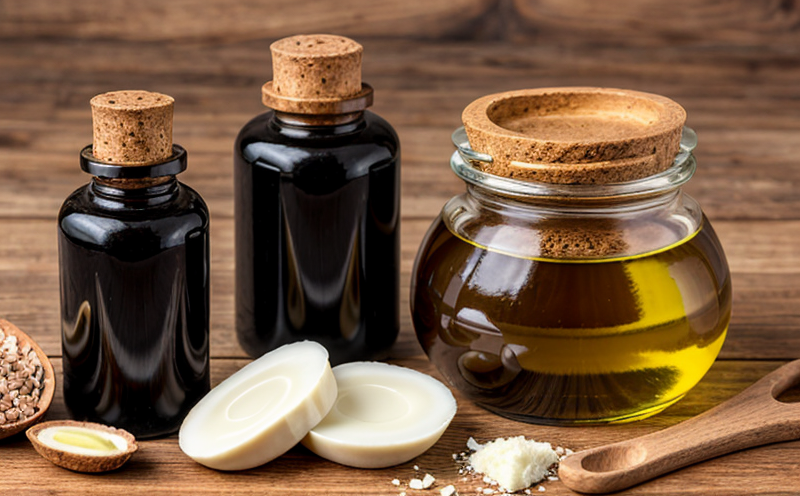AOAC 965.34 Iodine Value in Oils and Fats
The AOAC International method 965.34 is one of the most widely recognized procedures for determining the iodine value of oils and fats. This test measures the amount of iodine that can be absorbed by a sample, which provides insights into the unsaturated fatty acid content. This information is critical in quality control and compliance assessments across various sectors including food & feed production.
The iodine value is an important metric because it helps determine the oxidative stability of fats and oils. A higher iodine value indicates greater unsaturation, which can affect shelf life and stability. For instance, a high iodine value in cooking oils suggests they are more susceptible to rancidity when exposed to heat or light.
The procedure involves adding a known amount of iodine to the sample and titrating it with sodium thiosulfate until the reaction is complete. The endpoint is often determined by starch indicator, which changes color as the reaction progresses. The quantity of iodine absorbed can then be calculated based on the volume of sodium thiosulfate used in the titration.
For our laboratory, we use state-of-the-art analytical instruments such as automated titrators and precise weighing systems to ensure accuracy and precision. Our team is well-versed in this method and adheres strictly to international standards like ISO 5509 for fatty acid determination by titrimetric methods.
The reliability of the iodine value measurement depends heavily on proper sample preparation. Samples must be representative, homogenous, and free from contamination. This often involves mechanical or chemical purification steps before analysis.
Understanding the iodine value is crucial in industries like food & feed where quality assurance plays a vital role. For instance, it helps ensure that products meet regulatory standards set by bodies such as the FDA or EU regulations on fat content. In R&D settings, it allows for optimization of processes to improve product quality.
Compliance officers will find this test particularly useful in ensuring adherence to international standards and local laws regarding food safety and quality. By accurately measuring iodine values, they can verify that products are within acceptable limits set by these regulations.
- Quality Control: Ensures consistency in product quality.
- Regulatory Compliance: Meets international standards for fat content in food & feed products.
In summary, the AOAC 965.34 method is an essential tool for assessing the unsaturated fatty acid content of oils and fats. Its accuracy and precision make it indispensable in quality management and compliance processes across various sectors within the food & feed industry.
Quality and Reliability Assurance
The reliability and accuracy of our AOAC 965.34 analysis are guaranteed through rigorous internal quality control measures. Our laboratory adheres to strict protocols that ensure every test is conducted under controlled conditions. We employ advanced analytical instruments calibrated regularly using certified reference materials.
- Calibration: Instruments are calibrated daily before each use.
- Reference Materials: Use of international standards like ISO 5509 for consistency in results.
We also maintain detailed records of all analytical procedures, including calibration certificates and traceability documentation. This ensures that our methods can be replicated by other laboratories if necessary. Our team undergoes continuous training to stay updated with the latest techniques and technologies in oil & fat analysis.
Our commitment to quality is further reinforced through participation in proficiency testing programs organized by reputable organizations like AOAC International or ISO. These external validations provide additional assurance of our analytical capabilities and help identify any potential improvements needed.
The precision of the iodine value measurement relies on accurate sample preparation, which includes thorough cleaning procedures for glassware, precise weighing techniques, and careful titration methods. By adhering to these stringent protocols, we minimize sources of error and enhance the reliability of our test results.
International Acceptance and Recognition
The AOAC 965.34 method enjoys widespread acceptance globally due to its robustness and reproducibility. It is recognized by numerous international organizations including the Food and Agriculture Organization (FAO), World Health Organization (WHO), and several national standards bodies such as ASTM International.
- ISO 5509: Our method aligns closely with this international standard for fatty acid determination in oils and fats.
- American Oil Chemists' Society (AOCS): AOAC is a member of the AOCS, ensuring compatibility between our methods and those used by other leading industry experts.
The method's broad acceptance translates to its utility across different markets. For instance, it is commonly used in North America for compliance with FDA regulations on food safety and quality. Similarly, it finds application in Europe where adherence to EU directives governing fat content in foods is crucial.
Global acceptance also means that results from our AOAC 965.34 analysis are widely accepted by importers and regulators around the world. This enhances market access for food & feed producers who rely on accurate iodine value measurements as part of their quality assurance processes.
Competitive Advantage and Market Impact
Accurate iodine value measurement using AOAC 965.34 is a key differentiator in maintaining high standards of product quality. In an increasingly competitive market, ensuring consistent product quality can significantly impact customer satisfaction and loyalty.
For procurement teams looking to source the highest quality raw materials, this test provides valuable insights into the unsaturated fatty acid content of oils and fats. This information helps them make informed decisions about suppliers, thereby reducing risks associated with substandard products entering their supply chain.
In research and development (R&D) settings, precise iodine value measurements are crucial for process optimization aimed at improving product quality. By identifying optimal conditions that enhance the iodine value of fats used in food & feed formulations, R&D teams can innovate more effectively.
The ability to demonstrate compliance with international standards adds significant credibility to a company's reputation. This is particularly important when entering new markets where stringent regulations are enforced. Demonstrating adherence to AOAC 965.34 ensures that products meet the required quality thresholds set by these markets, thus facilitating easier market entry.





